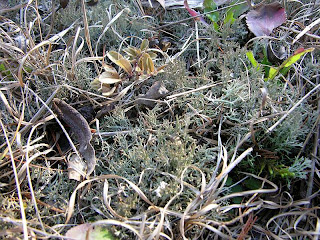Until the 1920's the Amercian Chestnut (
Castanea dentata) was a dominant tree species of southern Appalachian forests preferring well-drained upland slope habitat with acidic soils. It was commonly found growing among a variety of oak species and tulip poplar that preferred the same soil conditions and occupied up to 25% of climax forest canopies. In 1904 a fungus (
Cryphonectria parasitica) introduced at the Bronx Zoo in New York City from an infected blight-resistant Chinese Chestnut tree began a domino effect of destruction that would reduce one of the most important hardwood trees of the Appalacian forests to a cherished memory in alomst the blink of an eye. In a matter of a couple of decades an estimated 3.5 billion chestnut trees were destroyed in the forests of southern Appalachia changing the forest ecosystem in a way never before seen.
Except for a handfull of blight resistant indivuduals, most American Chestnut trees now exist as small shoots protruding from ancient rotting stumps. Most of the shoots will only grow a few feet before succumbing to the fungus, but a few exceptions sometimes make it to reporductive age and produce nuts before expiring. The fungus enters the tissue of the tree through cracks that occur in the bark forming lesions that begin expanding until they disrupt the flow of water and nutrients from the roots to the leaves. Interestingly, the fungus can only survive above ground which is why stumps of old trees remain active years after the trunks and canopies perish.
A little over a century after the blight's introduction scientists' hopes of resurrecting a genetically pure, blight resistant American Chestnut are becoming more of a reality. Using the resistance of the Chinese Chestnut's genome, botanists graft scions (green twigs) from chinese trees with those of native trees which gives the natives resistance. If the grafted tree lives to reproductive age, nuts can be collected and germinated in the hopes that the resistance will be inherited in some with all of the American genomic characteristics. It's a slow and tedious process but you can help provided you have the time and space to grow your own chestnut seedlings. Virgina Tech's Department of Plant Pathology, Physiology and Weed Science is sponsoring a program to reintroduce genetically pure American Chestnuts into the wild through the American Chestnut Cooperator's Foundation.
Click on the link below to view VaTech's site and guidelines for ordering chestnut seeds. There is alot of great information:
Virginia Tech American Chestnut Reintroduction Program
*
Sidenote - Chestnuts traditionally prefer well-drained acidic soils. Since much of the Captina watershed area is composed of alkaline Pennsylvanian limestone bedrock, traditional chestnut habitat may have been restricted to higher, ridgetops with sandstone outcrops. Pre-blight chestnut coverage in the watershed is not known but I have yet to see a remnant stump with young shoots which leads me to believe that maybe their distrubution here was not as widespread as in southern Ohio and West Virginia. Slopes containing pure stands of oak or tulip poplar may be good places to look for these stumps.
Anyone with records of Chestnut growth or knowledge of native American Chestnut trees growing in the Captina watershed should contact the Belmont Soil and Water Conservation office at (740) 526-0027.
















